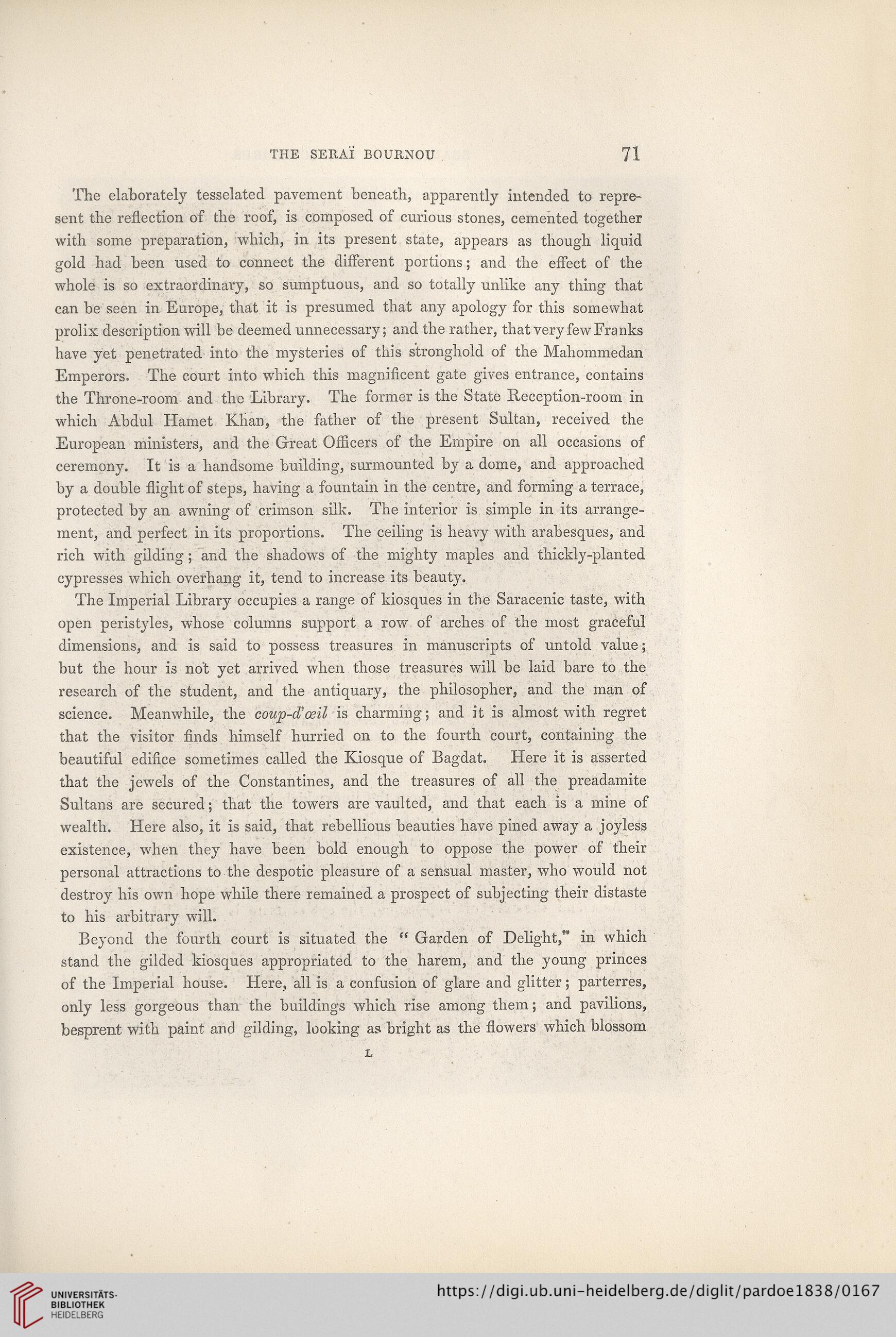THE SERAI BOURNOU
71
The elaborately tesselated pavement beneath, apparently intended to repre-
sent the reflection of the roof, is composed of curious stones, cemented together
with some preparation, which, in its present state, appears as though liquid
gold had been used to connect the different portions; and the effect of the
whole is so extraordinary, so sumptuous, and so totally unlike any thing that
can be seen in Europe, that it is presumed that any apology for this somewhat
prolix description will be deemed unnecessary; and the rather, that very few Franks
have yet penetrated into the mysteries of this stronghold of the Mahommedan
Emperors. The court into which this magnificent gate gives entrance, contains
the Throne-room and the Library. The former is the State Reception-room in
which Abdul Hamet Khan, the father of the present Sultan, received the
European ministers, and the Great Officers of the Empire on all occasions of
ceremony. It is a handsome building, surmounted by a dome, and approached
by a double flight of steps, having a fountain in the centre, and forming a terrace,
protected by an awning of crimson silk. The interior is simple in its arrange-
ment, and perfect in its proportions. The ceiling is heavy with arabesques, and
rich with gilding; and the shadows of the mighty maples and thickly-planted
cypresses which overhang it, tend to increase its beauty.
The Imperial Library occupies a range of kiosques in the Saracenic taste, with
open peristyles, whose columns support a row of arches of the most graceful
dimensions, and is said to possess treasures in manuscripts of untold value;
but the hour is not yet arrived when those treasures will be laid bare to the
research of the student, and the antiquary, the philosopher, and the man of
science. Meanwhile, the coup-d'oeil is charming; and it is almost with regret
that the visitor finds himself hurried on to the fourth court, containing the
beautiful edifice sometimes called the Kiosque of Bagdat. Here it is asserted
that the jewels of the Constantines, and the treasures of all the preadamite
Sultans are secured; that the towers are vaulted, and that each is a mine of
wealth. Here also, it is said, that rebellious beauties have pined away a joyless
existence, when they have been bold enough to oppose the power of their
personal attractions to the despotic pleasure of a sensual master, who would not
destroy his own hope while there remained a prospect of subjecting their distaste
to his arbitrary will.
Beyond the fourth court is situated the " Garden of Delight," in which
stand the gilded kiosques appropriated to the harem, and the young princes
of the Imperial house. Here, all is a confusion of glare and glitter; parterres,
only less gorgeous than the buildings which rise among them; and pavilions,
besprent with paint and gilding, looking as bright as the flowers which blossom
L
71
The elaborately tesselated pavement beneath, apparently intended to repre-
sent the reflection of the roof, is composed of curious stones, cemented together
with some preparation, which, in its present state, appears as though liquid
gold had been used to connect the different portions; and the effect of the
whole is so extraordinary, so sumptuous, and so totally unlike any thing that
can be seen in Europe, that it is presumed that any apology for this somewhat
prolix description will be deemed unnecessary; and the rather, that very few Franks
have yet penetrated into the mysteries of this stronghold of the Mahommedan
Emperors. The court into which this magnificent gate gives entrance, contains
the Throne-room and the Library. The former is the State Reception-room in
which Abdul Hamet Khan, the father of the present Sultan, received the
European ministers, and the Great Officers of the Empire on all occasions of
ceremony. It is a handsome building, surmounted by a dome, and approached
by a double flight of steps, having a fountain in the centre, and forming a terrace,
protected by an awning of crimson silk. The interior is simple in its arrange-
ment, and perfect in its proportions. The ceiling is heavy with arabesques, and
rich with gilding; and the shadows of the mighty maples and thickly-planted
cypresses which overhang it, tend to increase its beauty.
The Imperial Library occupies a range of kiosques in the Saracenic taste, with
open peristyles, whose columns support a row of arches of the most graceful
dimensions, and is said to possess treasures in manuscripts of untold value;
but the hour is not yet arrived when those treasures will be laid bare to the
research of the student, and the antiquary, the philosopher, and the man of
science. Meanwhile, the coup-d'oeil is charming; and it is almost with regret
that the visitor finds himself hurried on to the fourth court, containing the
beautiful edifice sometimes called the Kiosque of Bagdat. Here it is asserted
that the jewels of the Constantines, and the treasures of all the preadamite
Sultans are secured; that the towers are vaulted, and that each is a mine of
wealth. Here also, it is said, that rebellious beauties have pined away a joyless
existence, when they have been bold enough to oppose the power of their
personal attractions to the despotic pleasure of a sensual master, who would not
destroy his own hope while there remained a prospect of subjecting their distaste
to his arbitrary will.
Beyond the fourth court is situated the " Garden of Delight," in which
stand the gilded kiosques appropriated to the harem, and the young princes
of the Imperial house. Here, all is a confusion of glare and glitter; parterres,
only less gorgeous than the buildings which rise among them; and pavilions,
besprent with paint and gilding, looking as bright as the flowers which blossom
L




